1、输出1

答案:
`timescale 1ns/1ns
module top_module(
output wire one
);
assign one = 1'b1;
endmodule
2、wire连线

答案:
`timescale 1ns/1ns
module wire0(
input wire in0,
output wire out1
);
assign out1 = in0;
endmodule
3、多wire连线
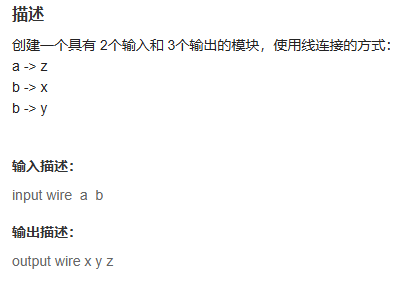
`timescale 1ns/1ns
module top_module(
input wire a,
input wire b,
output wire x,
output wire y,
output wire z
);
assign z = a;
assign x = b;
assign y = b;
endmodule
4、反相器

答案:
`timescale 1ns/1ns
module top_module(
input in,
output out
);
assign out = ~in;
endmodule
5、与门

答案:
`timescale 1ns/1ns
module top_module(
input a,
input b,
input c,
output d );
wire temp;
and gate(temp, a, b);
and gate(d, temp, c);
endmodule
6、NOR门
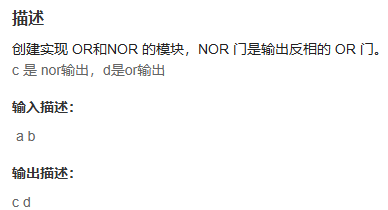
答案:
`timescale 1ns/1ns
module top_module(
input a,
input b,
output c,
output d);
or gate(d, a, b);
not gate(c, d);
endmodule
7、XOR门
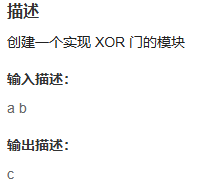
答案:
`timescale 1ns/1ns
module top_module(
input a,
input b,
output c );
assign c = a^b;
endmodule
8、逻辑运算
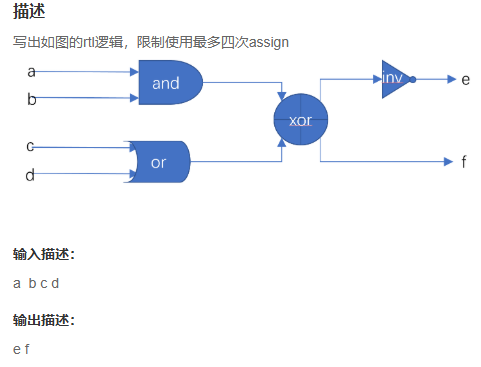
答案:
`timescale 1ns/1ns
module top_module (
input a,
input b,
input c,
input d,
output e,
output f );
wire out1, out2;
assign out1 = a & b;
assign out2 = c | d;
assign f = out1 ^ out2;
assign e = ~f;
endmodule
9、模拟逻辑芯片
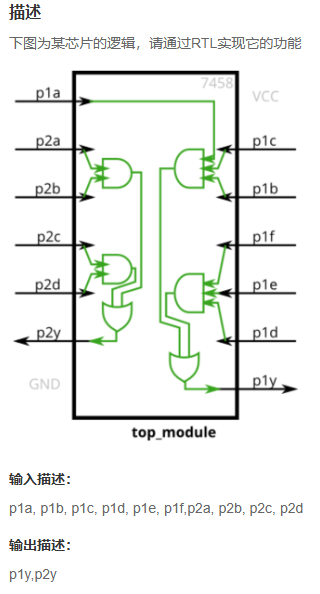
答案:
`timescale 1ns/1ns
module top_module (
input p1a, p1b, p1c, p1d, p1e, p1f,
output p1y,
input p2a, p2b, p2c, p2d,
output p2y );
wire out1, out2, out3, out4;
assign out1 = p2a & p2b;
assign out2 = p1a & p1c & p1b;
assign out3 = p2c & p2d;
assign out4 = p1f & p1e & p1d;
assign p1y = out2 | out4;
assign p2y = out1 | out3;
endmodule
10、逻辑运算2
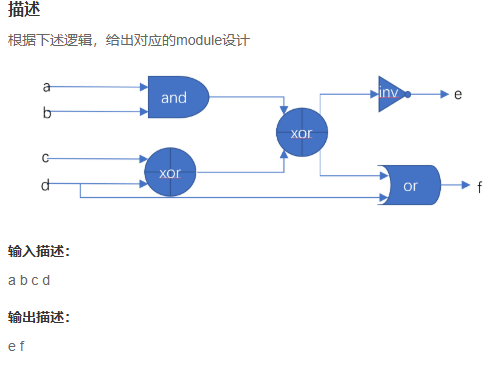
答案:
`timescale 1ns/1ns
module top_module (
input a,
input b,
input c,
input d,
output e,
output f );
wire out1, out2, out3;
assign out1 = a & b;
assign out2 = c ^ d;
assign out3 = out1 ^ out2;
assign f = out3 | d;
assign e = ~out3;
endmodule
11、多位信号
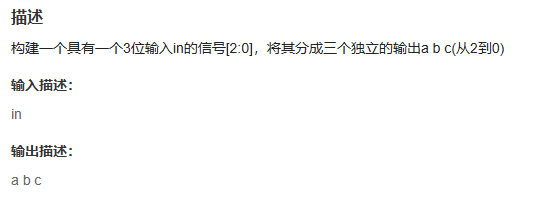
答案:
`timescale 1ns/1ns
module top_module(
input wire [2:0] in,
output a,b,c
);
assign a = in[2];
assign b = in[1];
assign c = in[0];
endmodule
12、信号顺序调整

答案:
`timescale 1ns/1ns
module top_module(
input [15:0] in,
output out
);
assign out = {in[3:0], in[7:4], in[11:8], in[15:11]};
endmodule
13、位运算与逻辑运算

答案:
`timescale 1ns/1ns
module top_module(
input [2:0] a,
input [2:0] b,
output [2:0] c,
output d
);
assign c = a | b;
assign d = a || b;
endmodule
14、对信号按位操作
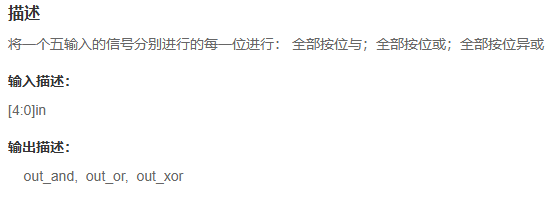
答案:
`timescale 1ns/1ns
module top_module(
input [4:0] in,
output out_and,
output out_or,
output out_xor
);
assign out_and = &in[4:0];
assign out_or = |in[4:0];
assign out_xor = ^in[4:0];
endmodule
15、信号级联合并

答案:
`timescale 1ns/1ns
module top_module(
input [4:0] a, b, c, d, e, f,
output [7:0] w, x, y, z );
wire [31:0] out;
assign out = {a, b, c, d, e, f, {2'b11}};
assign w = out[31:24];
assign x = out[23:16];
assign y = out[15:8];
assign z = out[7:0];
endmodule
16、信号反转输出

答案:
`timescale 1ns/1ns
module top_module(
input [15:0] in,
output [15:0] out
);
genvar i;
generate
for(i = 0; i < 16; i = i + 1) begin
assign out[i] = in[15-i];
end
endgenerate
endmodule
17、三元操作符

答案:
`timescale 1ns/1ns
module top_module(
input [7:0] a, b, c, d,
output [7:0] max);//
wire [7:0] temp1, temp2;
assign temp1 = (a > b)? a : b;
assign temp2 = (temp1 > c)? temp1 : c;
assign max = (temp2 > d)? temp2 : d;
endmodule
18、 多位信号xnor

答案:
`timescale 1ns/1ns
module top_module(
input a, b, c, d, e,
output [24:0] out
);
wire [24:0] temp1, temp2;
assign temp1 = {{5{a}}, {5{b}}, {5{c}}, {5{d}}, {5{e}}};
assign temp2 ={5{a,b,c,d,e}};
assign out = ~(temp1 ^ temp2);
endmodule
19、五到一选择器
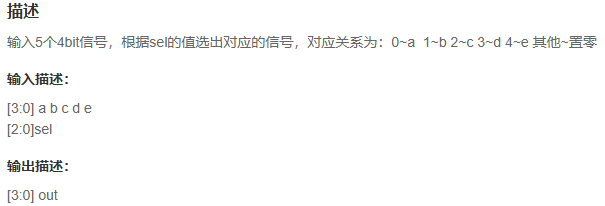
答案:
`timescale 1ns/1ns
module top_module(
input [3:0] a, b, c, d, e,
input [2:0] sel,
output reg [3:0] out );
always @(*)begin
out = (sel == 0)? a : (sel == 1)? b : (sel == 2)? c : (sel == 3)? d : (sel == 4)? e : 4'b0;
end
endmodule
20、 256选1选择器

答案:
`timescale 1ns/1ns
module top_module (
input [255:0] in,
input [7:0] sel,
output out
);
assign out = in[sel];
endmodule
 网硕互联帮助中心
网硕互联帮助中心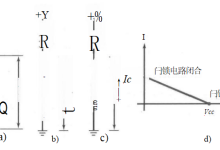

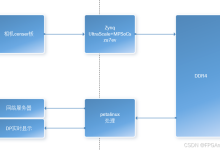




评论前必须登录!
注册